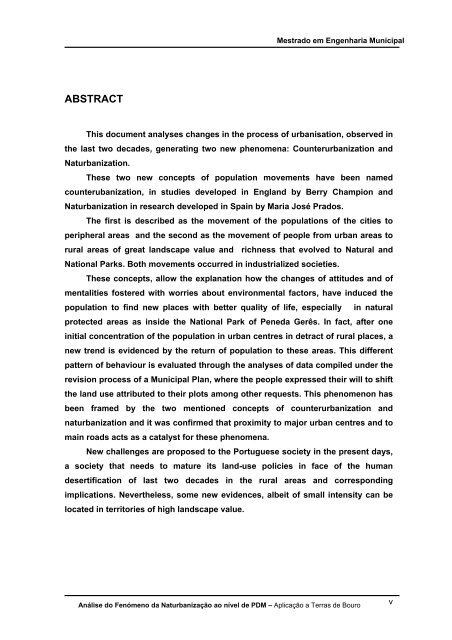1 Tese de Mestrado Fernando Barros-parte II - Universidade do Minho
1 Tese de Mestrado Fernando Barros-parte II - Universidade do Minho
1 Tese de Mestrado Fernando Barros-parte II - Universidade do Minho
You also want an ePaper? Increase the reach of your titles
YUMPU automatically turns print PDFs into web optimized ePapers that Google loves.
ABSTRACT<br />
<strong>Mestra<strong>do</strong></strong> em Engenharia Municipal<br />
This <strong>do</strong>cument analyses changes in the process of urbanisation, observed in<br />
the last two <strong>de</strong>ca<strong>de</strong>s, generating two new phenomena: Counterurbanization and<br />
Naturbanization.<br />
These two new concepts of population movements have been named<br />
counterubanization, in studies <strong>de</strong>veloped in England by Berry Champion and<br />
Naturbanization in research <strong>de</strong>veloped in Spain by Maria José Pra<strong>do</strong>s.<br />
The first is <strong>de</strong>scribed as the movement of the populations of the cities to<br />
peripheral areas and the second as the movement of people from urban areas to<br />
rural areas of great landscape value and richness that evolved to Natural and<br />
National Parks. Both movements occurred in industrialized societies.<br />
These concepts, allow the explanation how the changes of attitu<strong>de</strong>s and of<br />
mentalities fostered with worries about environmental factors, have induced the<br />
population to find new places with better quality of life, especially in natural<br />
protected areas as insi<strong>de</strong> the National Park of Peneda Gerês. In fact, after one<br />
initial concentration of the population in urban centres in <strong>de</strong>tract of rural places, a<br />
new trend is evi<strong>de</strong>nced by the return of population to these areas. This different<br />
pattern of behaviour is evaluated through the analyses of data compiled un<strong>de</strong>r the<br />
revision process of a Municipal Plan, where the people expressed their will to shift<br />
the land use attributed to their plots among other requests. This phenomenon has<br />
been framed by the two mentioned concepts of counterurbanization and<br />
naturbanization and it was confirmed that proximity to major urban centres and to<br />
main roads acts as a catalyst for these phenomena.<br />
New challenges are proposed to the Portuguese society in the present days,<br />
a society that needs to mature its land-use policies in face of the human<br />
<strong>de</strong>sertification of last two <strong>de</strong>ca<strong>de</strong>s in the rural areas and corresponding<br />
implications. Nevertheless, some new evi<strong>de</strong>nces, albeit of small intensity can be<br />
located in territories of high landscape value.<br />
Análise <strong>do</strong> Fenómeno da Naturbanização ao nível <strong>de</strong> PDM – Aplicação a Terras <strong>de</strong> Bouro<br />
v

















